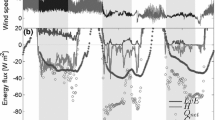Abstract
Mack (1977) criticized methods referring to a single frequency perturbation for correlation of transition prediction because the external disturbance source (like free stream turbulence) should have a broadband spectrum. Delta-correlated perturbations are characterized by the mean square of physical amplitude, which is expressed as a double integral of the power spectral density in frequency and the spanwise wave number. It is suggested to evaluate this integral asymptotically. The results obtained using the asymptotic method and direct numerical integration are compared with ad hoc approaches for high speed and moderate supersonic boundary layers. This allows us to suggest recommendations on rational usage of the amplitude method with avoiding unconfirmed simplifications while reducing the computational effort to the level affordable for engineering practice.






















Similar content being viewed by others
Notes
Such factors like temperature spottiness or particulates in atmosphere may vary from region to region, seasons, day time, etc. and hardly are predictable. It means that, finally, a designer has to make a decision on the scenario and design point choice.
See a clarification of the terminology in Ref. [15]
In the variable \(e^N\) method [11], which deals with the spectral lines, the bandwidth factor \(A_F\) is not taken into account at all.
References
Arnal, D.: Description and prediction of transition in two-dimensional, incompressible flow. Tech. rep. (1984). AGARD Report 709, Special Course on Stability and Transition of Laminar Flow
Arnal, D.: Transition prediction in industrial applications. In: Hanifi, A., Alfredson, P.H., Johansson, A.V., Henningson, D.S. (eds.) Transition, Turbulence and Combustion modelling, pp. 105–157. Springer Science + Buisness Media, B. V. (1999)
Arnal, D., Casalis, G.: Laminar-turbulent transition prediction in three-dimensional flows. Prog. Aero. Sci. 36, 173–191 (2000)
Bleistein, N.: Mathematical Methods for Wave Phenomena. Academic Press, Cambridge (1984)
Bleistein, N., Handelsman, R.A.: Asymptotic Expansions of Integrals. Dover, New York (1986)
Bushnell, D.: Notes on initial disturbances fields for the transition problem. M.Y. Hussaini, R.G. Voigt 1, 217–232 (1990)
Chang, C.L.: The langley stability and transition analysis code (lastrac): Lst, linear & nonlinear PSE for 2-d, axisymmetric, and infinite swept wing boundary layers. AIAA Paper 2003–974, (2003)
Chang, C.L.: Lastrac.3d: transition prediction in 3d boundary layers. AIAA Paper 2004–2542 (2004)
Chang, C.L., Choudhari, M.: Boundary-layer receptivity and integrated transition prediction. AIAA Paper 2005–0526, (2005)
Crouch, J.D., Crouch, I.W.M., Ng, L.L.: Estimating the laminar/turbulent transition location in three-dimensional boundary layers for cfd applications. AIAA Paper, 2001–2989, (2001)
Crouch, J.D., Ng, L.L.: Variable n-factor method for transition prediction in three-dimensional boundary layers. AIAA J. 38(2), 211–216 (2017)
Edwards, L.D., Tumin, A.: A model of distributed receptivity to kinetic fluctuations in high-speed boundary layers. AIAA J. 57(11), 4750–4763 (2019)
Egorov, I.V., Fedorov, A.V., Novikov, A.V., Chuvakhov, P.V.: The role of receptivity in prediction of high-speed laminar-turbulent transition. In: Henningson D. (ed.) IUTAM Symposium on Laminar-Turbulent Transition. Springer (2019). To be published
Fedorov, A.: Transition and stability of high-speed boundary layers. Ann. Rev. Fluid Mech. 43, 79–95 (2011)
Fedorov, A., Tumin, A.: High-speed boundary-layer instability: Old terminology and a new framework. AIAA J. 49(8), 1647–1657 (2011). https://doi.org/10.2514/1.J050835
Fedorov, A., Tumin, A.: Receptivity of high-speed boundary layers to kinetic fluctuations. AIAA J. 55(7), 2335–2348 (2017)
Forgoston, E., Tumin, A.: Three-dimensional wave packets in a compressible boundary layer. Phys. Fluids 18(10), 104103 (2006). https://doi.org/10.1063/1.2359003
Johnson, H.B., Candler, G.V.: PSE analysis of reacting hypersonic boundary layer transition. AIAA Paper 1999–3793, (1999)
Johnson, H.B., Candler, G.V.: Hypersonic boundary layer stability analysis using PSE-chem. AIAA Paper 2005–5023, (2005)
Mack, L.M.: Boundary-layer stability theory. Technical report 900-277, Rev. A (1969)
Mack, L.M.: Transition and laminar instability. NASA-CP-153203 (1977)
Marineau, E.C.: Prediction methodology for 2nd mode dominated boundary layer transition in hypersonic wind tunnels. AIAA Paper 2016–0597, (2016)
Marineau, E.C.: Prediction methodology for second-mode dominated boundary-layer transition in wind tunnels. AIAA J. 55(2), 484–499 (2017)
Marineau, E.C., Moraru, C.G., Lewis, D.R., Joseph, N.D., Lafferty, J.F., Wagnild, R.M., Justin, S.A.: Mach 10 boumdary-layer transition experiments on sharp and blunted cones. AIAA Paper 2014–3108, (2014)
Marineau, E.C., Moraru, C.G., Lewis, D.R., Norris, J.D., Lafferty, J.F., Johnson, H.: Investigation of mach 10 boundary layer stability of sharp cones at angle-of-attack, part 1: Experiments. AIAA Paper 2015–1737,(2015)
Reed, H.L., Saric, W.S., Arnal, D.: Transition, pressure gradient and stability theory. Ann. Rev. Fluid Mech. 28, 289–428 (1996)
Saric, W.S., Reed, H.L., White, E.B.: Stability and transition of three-dimensional boundary layers. Ann. Rev. Fluid Mech. 35, 413–440 (2003)
Smith, A.M.O., Gamberoni, N.: Transition, pressure gradient and stability theory. Technical report ES 26388, El Segundo Division (1956)
Stetson, K.F., Kimmel, R.L.: On hypersonic boundary-layer stability. AIAA Paper 92–0737, (1992)
Tumin, A.: Flow instabilities and transition. In: Blocley, R., Shyy, W. (eds.) Encyclopedia of Aerospace Engineering, pp. 139–150. John Wiley & Sons Ltd, Chichester, UK (2010)
van Ingen, J.L.: A suggested semi-empirical method for the calculation of boundary layer transition region. Technical report UTH-74, Delft,Netherlands (1956)
Wong, R.: Asymptotic Approximations of Integrals. SIAM, Philadelphia (2001)
Acknowledgements
The authors thank Ms. Michelle Bailey for assistance in the computations. A. Fedorov (Sect. 3) was supported by the Russian Scientific Foundation (project No. 19-19-00470). A. Tumin was supported by ONR Grant N00014-20-1-2502 monitored by Dr. E. Marineau.
Author information
Authors and Affiliations
Corresponding author
Additional information
Communicated by Vassilios Theofilis.
Publisher's Note
Springer Nature remains neutral with regard to jurisdictional claims in published maps and institutional affiliations.
Rights and permissions
About this article
Cite this article
Fedorov, A., Tumin, A. The Mack’s amplitude method revisited. Theor. Comput. Fluid Dyn. 36, 9–24 (2022). https://doi.org/10.1007/s00162-021-00575-x
Received:
Accepted:
Published:
Issue Date:
DOI: https://doi.org/10.1007/s00162-021-00575-x




